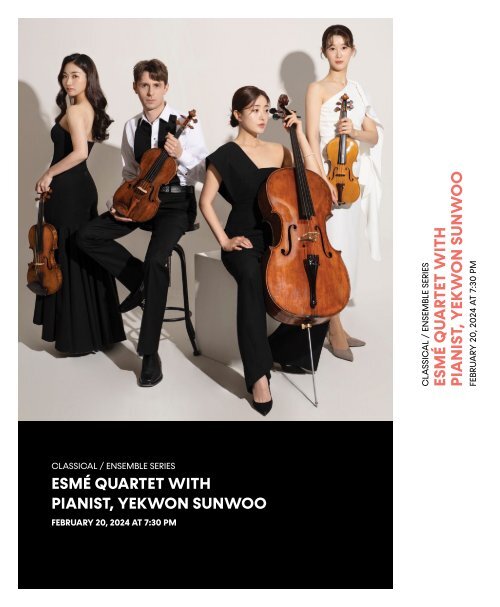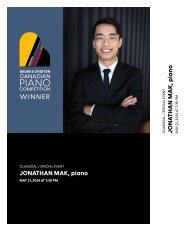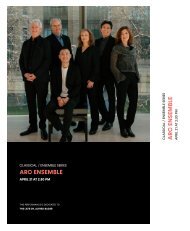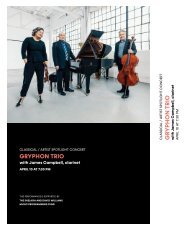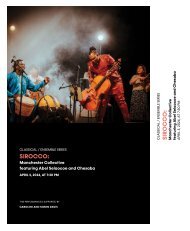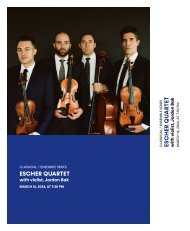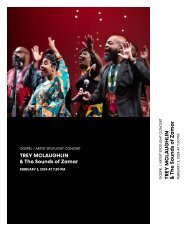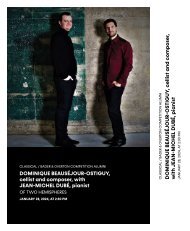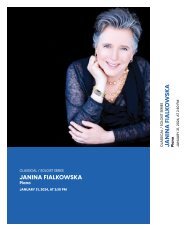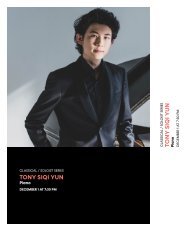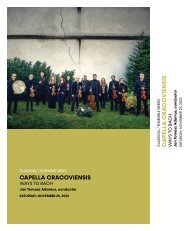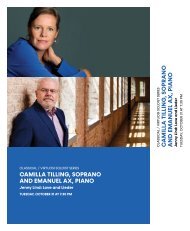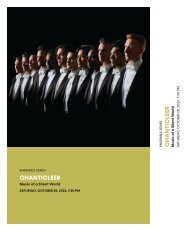Create successful ePaper yourself
Turn your PDF publications into a flip-book with our unique Google optimized e-Paper software.
CLASSICAL / ENSEMBLE SERIES<br />
ESMÉ QUARTET WITH<br />
PIANIST, YEKWON SUNWOO<br />
FEBRUARY <strong>20</strong>, <strong>20</strong>24 AT 7:30 PM<br />
CLASSICAL / ENSEMBLE SERIES<br />
ESMÉ QUARTET WITH<br />
PIANIST, YEKWON SUNWOO<br />
FEBRUARY <strong>20</strong>, <strong>20</strong>24 AT 7:30 PM
CLASSICAL / ENSEMBLE SERIES<br />
ESMÉ QUARTET<br />
WITH PIANIST,<br />
YEKWON SUNWOO<br />
PROGRAM<br />
ESMÉ QUARTET<br />
Wonhee Bae, Violin I<br />
Yuna Ha, Violin II<br />
Dimitri Murrath, Viola<br />
Yeeun Heo, Cello<br />
WITH<br />
<strong>Yekwon</strong> <strong>Sunwoo</strong>, Piano<br />
FRANZ JOSEPH HAYDN<br />
FANNY MENDELSSOHN<br />
String <strong>Quartet</strong> in E Flat Major,<br />
“The Joke,” Op. 33, No. 2<br />
Allegro moderato<br />
Scherzo<br />
Largo e sostenuto<br />
Finale<br />
String <strong>Quartet</strong> in E Flat Major<br />
Adagio ma non troppo<br />
Allegretto<br />
Romanze<br />
Allegro molto vivace<br />
INTERMISSION<br />
JOHANNES BRAHMS Piano Quintet in F Minor, Opus 34<br />
Allegro non troppo<br />
Andante, un poco adagio<br />
Scherzo: Allegro – Trio<br />
Finale: Poco sostenuto – Allegro<br />
non troppo – Presto non troppo
PROGRAM NOTES<br />
The string quartet that opens tonight’s concert is<br />
remarkable for the joyously light character that<br />
pervades much of the music. Its nickname, “The<br />
Joke,” is certainly well deserved for two reasons:<br />
first, instead of a Minuet, Haydn writes a faster<br />
Scherzo which includes a Trio that makes great<br />
use of surprising glissandos (or slides) into<br />
pitches; and second, for the way in which the<br />
last movement ends <strong>with</strong> a coda that keeps<br />
interjecting silences that generate a series of false<br />
endings before the final cadence whispers away.<br />
For the vast majority of women musicians and<br />
composers, life and posterity have not been kind,<br />
<strong>with</strong> a clear case of such gender injustice found<br />
in the career and music of Fanny Mendelssohn<br />
(1805-1847). Felix’s older sister by three years,<br />
Fanny was by all accounts just as precocious as<br />
her younger brother, and despite being provided<br />
<strong>with</strong> the same musical tutors as Felix, was<br />
expected to marry and run a family household.<br />
She followed this domestic path, marrying the<br />
Berlin court painter Wilhelm Hensel in 1829, which<br />
coincidentally, was the same year that she began<br />
sketches for a piano sonata that in 1834 she<br />
adapted into her only string quartet. Beyond this<br />
scant information, little more is known of this work<br />
until the music was published in 1988 by Breitkipf<br />
& Härtel, a long-standing publisher of Felix’s<br />
music. The work has since gained considerable<br />
popularity <strong>with</strong> modern audiences for the way it<br />
demonstrates its own unique originality. This can<br />
be immediately heard in the fantasy-like opening<br />
movement that starts expressively in C minor, and<br />
only towards the end settles into the work’s home<br />
key of E flat major. The second movement returns<br />
to C minor in the fast, filigree-like outer sections<br />
that are offset <strong>with</strong> the vibrant fugal writing of<br />
the C major Trio. The Romanze in G minor, displays<br />
subtle fluidity in the melodic writing such that the<br />
music never seems to cadence but is continually<br />
spun into new sections. The final movement, <strong>with</strong><br />
its clear Rondo design and emphasis on exciting<br />
two-part counterpoint doubled at the unison or<br />
in octaves, rounds off the work quite triumphantly<br />
in E flat major.<br />
Many composers seem to have followed Robert<br />
Schumann’s model of writing only one piano<br />
quintet during their careers and making this work<br />
almost symphonic in design and length. Brahms<br />
(1833-1897), whose early career received much<br />
encouragement from Robert Schumann, likewise<br />
composed only one piano quintet. Curiously,<br />
the Brahms piano quintet started out as a string<br />
quintet but was completed as a sonata for two<br />
pianos (a version that is performed today as Opus<br />
34B). At Clara Schumann’s urging, this two-piano<br />
work was adapted for piano and string quartet,<br />
and it is this arrangement that has become a<br />
favourite of chamber music performers and<br />
audiences. All four movements display melodies<br />
and musical textures that are immediately<br />
captivating while at the same time are organized<br />
to support the music’s larger structural form <strong>with</strong><br />
a high degree of controlled expansiveness.<br />
©<strong>20</strong>24 by John Burge for the Isabel<br />
ABOUT ESMÉ QUARTET<br />
At home in Germany, the Esmé <strong>Quartet</strong> is one of<br />
the most dynamic and multi-faceted string quartets<br />
of its generation, winning audiences and reviewers<br />
over <strong>with</strong> its infectious energy and immaculate<br />
ensemble playing. The four South Korean<br />
musicians’ ensemble was the first all-female string<br />
quartet to win the first prize and four special prizes,<br />
including the Mozart and the Beethoven Prize, at<br />
the <strong>20</strong>18 International String <strong>Quartet</strong> Competition<br />
at London’s Wigmore Hall: a sensational launch of<br />
an international string quartet career.<br />
This success in competition also proved the<br />
springboard for worldwide concert activities,<br />
ranging from the USA to Europe’s great musical<br />
centres and all the way to Asia, where they were<br />
celebrated during a prestigious residency at<br />
Seoul’s Lotte Concert Hall during the past season.<br />
Furthermore, innumerable concert tours and<br />
guest appearances have taken the Esmé <strong>Quartet</strong><br />
to festivals and concert halls such as the Lucerne<br />
Festival, the Verbier Festival, the Schleswig-<br />
Holstein Music Festival, London’s Wigmore Hall,<br />
the Flagey Musiq3 Festival in Brussels, L’Auditori<br />
in Barcelona, Teatro La Fenice in Venice, the<br />
Heidelberg String <strong>Quartet</strong> Fest and Hamburg’s<br />
Elbphilharmonie. In the summer of <strong>20</strong>18, they<br />
were also the <strong>Quartet</strong> in Residence at the<br />
Festival d’Aix-en-Provence.
In <strong>20</strong>19, the Esmé <strong>Quartet</strong> became HSBC Winner<br />
of the Festival d’Aix-en-Provence, also taking first<br />
prize at the 55th Possehl Music Prize in Lubeck.<br />
The <strong>Quartet</strong>’s debut CD, featuring works by<br />
Ludwig van Beethoven, Unsuk Chin and Frank<br />
Bridge released in early <strong>20</strong><strong>20</strong> by Alpha Classics,<br />
won a 5-star review from Diapason d’Or and was<br />
named one of the best classical albums of <strong>20</strong><strong>20</strong><br />
by WQXR Radio in New York. In October of that<br />
year, the Esmé <strong>Quartet</strong> also received the Hans<br />
Gal Prize of the German Academy of Sciences<br />
and Literature in Mainz and the Villa Musica<br />
Foundation.<br />
Highlights of the <strong>20</strong>22/23 season included<br />
extensive tours of America and Japan as well as<br />
invitations to London’s Wigmore Hall, Stuttgart’s<br />
Liederhalle and the Teatro Vittoria in Turin, in<br />
addition to three concerts at the <strong>20</strong>23 Hong Kong<br />
Arts Festival. One of these concerts featured the<br />
solo concerto Absolute Jest for string quartet and<br />
orchestra by John Adams, accompanied by the<br />
venerable Hong Kong Philharmonic Orchestra.<br />
The four musicians, who are bound by many years<br />
of friendship, have studied <strong>with</strong> Heime Muller<br />
(Artemis <strong>Quartet</strong>) in Lubeck and <strong>with</strong> Oliver Wille<br />
(Kuss <strong>Quartet</strong>) in Hanover. They also received<br />
important artistic impulses from Gunter Pichler<br />
(Alban Berg <strong>Quartet</strong>), Alfred Brendel, Eberhard<br />
Feltz, Andras Keller (Keller <strong>Quartet</strong>), Christoph<br />
Poppen and Jonathan Brown (Cuarteto Casals).<br />
In its concerts, the Esmé <strong>Quartet</strong>, whose name<br />
is derived from medieval French and means<br />
“beloved,” is celebrated for its spellbinding<br />
dynamics, stylistically assured interpretations and<br />
perfect ensemble playing, which has also aroused<br />
the interest of many renowned guest artists—as<br />
demonstrated most recently by their collaboration<br />
<strong>with</strong> Eckart Runge, the long-time cellist of the<br />
Artemis <strong>Quartet</strong>.<br />
ABOUT YEKWON SUNWOO<br />
<strong>Yekwon</strong> <strong>Sunwoo</strong> has been hailed for his<br />
“unfailingly consistent excellence” (International<br />
Piano) and celebrated as “a pianist who<br />
commands a comprehensive technical arsenal<br />
that allows him to thunder <strong>with</strong>out breaking<br />
a sweat” (Chicago Tribune). A powerful and<br />
virtuosic performer, he also, in his own words,<br />
“strives to reach for the truth and pure beauty<br />
in music.”<br />
The first Korean Gold medallist of the Van<br />
Cliburn International Piano Competition,<br />
<strong>Yekwon</strong>’s 23/24 season includes appearances<br />
<strong>with</strong> the Macao, Armenian, Kalamazoo & Victoria<br />
Symphonies, Slovak Philharmonic, Orchestre<br />
de Chambre de Paris as well as a US tour <strong>with</strong><br />
the Esmé String <strong>Quartet</strong>.<br />
In previous seasons, he has performed as soloist<br />
<strong>with</strong> the Munich Philharmonic and Valery Gergiev,<br />
Royal Danish Orchestra <strong>with</strong> Thomas Søndergård,<br />
Fort Worth and Tucson Symphonies, Washington<br />
Chamber Orchestra, Baltimore Symphony<br />
Orchestra, Houston Symphony, National Orchestra<br />
of Belgium, Sendai Philharmonic and Royal<br />
Scottish National Orchestra amongst others.<br />
Recital appearances include Carnegie Hall,<br />
Wigmore Hall, Elbphilharmonie, Salle Cortot,<br />
Hong Kong Arts Festival and a tour of Japan. An<br />
avid chamber musician, <strong>Yekwon</strong>’s collaborators<br />
include Benjamin Beilman, Linus Roth, Andrei<br />
Ionita, Sebastian Bohren, Isang Enders, Tobias<br />
Feldmann, Gary Hoffman, Anne-Marie McDermott<br />
and the Jerusalem and Brentano <strong>Quartet</strong>s. He has<br />
also toured Costa Rica, Guatemala and Panama<br />
<strong>with</strong> the Kumho Asiana Cultural Foundation and<br />
performed at Chamber Music of Lincoln Center’s<br />
Inside Chamber Music Lectures.<br />
In addition to the Cliburn Gold Medal, <strong>Yekwon</strong><br />
won first prizes at the <strong>20</strong>15 International German<br />
Piano Award, the <strong>20</strong>14 Vendome Prize held at<br />
the Verbier Festival, the <strong>20</strong>13 Sendai International<br />
Music Competition and the <strong>20</strong>12 William Kapell<br />
International Piano Competition.<br />
Born in Anyang, South Korea, <strong>Yekwon</strong> began<br />
learning the piano at the age of 8 and made<br />
his recital and orchestral debuts in Seoul at 15.<br />
His teachers include Seymour Lipkin, Robert<br />
McDonald, Richard Goode and Bernd Goetzke.<br />
In <strong>20</strong>17, Decca Gold released Cliburn Gold<br />
<strong>20</strong>17 two weeks after <strong>Yekwon</strong> was awarded<br />
the Gold Medal and includes his awardwinning<br />
performances of Ravel’s La Valse and<br />
Rachmaninov’s Second Piano Sonata. In <strong>20</strong><strong>20</strong><br />
<strong>Yekwon</strong> went on to release his first studio album<br />
for Decca Universal Music Korea featuring an all<br />
Mozart programme. His second album featuring<br />
Rachmaninov solo works was released in<br />
September <strong>20</strong>23.


